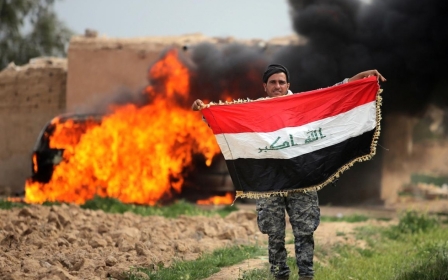Saddam Hussein’s tomb destroyed in fighting

Saddam Hussein’s tomb in his home city of Tikrit has been destroyed amidst the fighting between Islamic State militants and Iraqi forces, allied with Shiite volunteer militias.
Footage from the Associated Press shows that the once-lavish mausoleum is now reduced to rubble supported by bare columns. The structure was damaged as the fighting escalated in the north and south of Tikrit, after Iraqi military officials declared on Saturday that the entire city would be under their control in the space of three days.
Saddam Hussein was captured by United States forces in 2003 and hanged in 2006 after an Iraqi tribunal court found him guilty of committing crimes against humanity for the mass killings of the Kurds and Shiites of the country. He was buried in the village of Ouja, just south of Tikrit, in 2007, where the mausoleum contained a marble octagon at its centre with fresh flowers that covered thegrave where the body was buried.
A Shiite fighter said that the grounds outside the tomb was heavily booby-trapped by the Islamic State but that Iraqi forces did not suffer any casualties.
“This place was the most dangerous for IS,” said Captain Yasser Nu’ma of the volunteer Popular Mobilisation units. “Even the leadership said it would be difficult to enter this area. But thank God we managed to get in at 5am (0200 GMT) and by 10am (0700 GMT) everything was finished.”
Shiite militia flags and pictures of militia leaders, including Iranian General Qassem Soleimani, who has maintained a ubiquitous presence in commanding Iraqi Shiite forces, adorned the village of Ouja, replacing the posters and photos of Saddam.
IS had previously claimed in August that Saddam’s tomb was completely destroyed, but local officials said that the interiors were only burned and the mausoleum ransacked, suffering minor damages.
Iraqi media had reported last year that loyalists had moved Saddam’s body, citing fears that that it would be disturbed in the fighting. The location of the body is not known.
The Islamic State has controlled the northern city of Tikrit since June 2014, when Iraq’s second largest city Mosul also came under its control.
Human rights group previously expressed concern that civilians faced a great risk as the Iraqi forces, numbering 20,000, launched their military operation two weeks ago to retake Tikrit from IS.
Some leaders and fighters have described the operation as an opportunity to avenge the killing of military recruits at the hands of IS militants.
“Shiite paramilitary militias have often carried out reprisal sectarian attacks against Sunni civilians who are not involved in the hostilities,” said Donatella Rovera, Amnesty International’s senior crisis response adviser.
Middle East Eye propose une couverture et une analyse indépendantes et incomparables du Moyen-Orient, de l’Afrique du Nord et d’autres régions du monde. Pour en savoir plus sur la reprise de ce contenu et les frais qui s’appliquent, veuillez remplir ce formulaire [en anglais]. Pour en savoir plus sur MEE, cliquez ici [en anglais].




